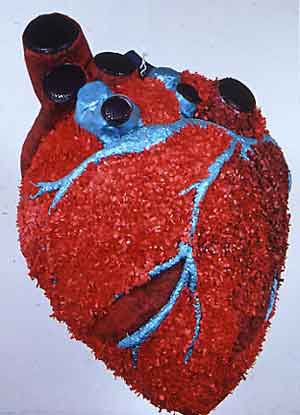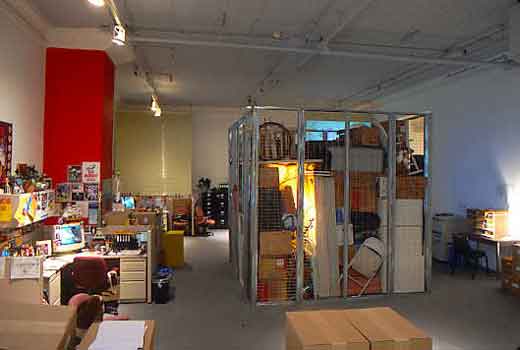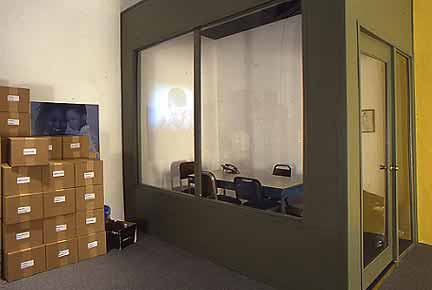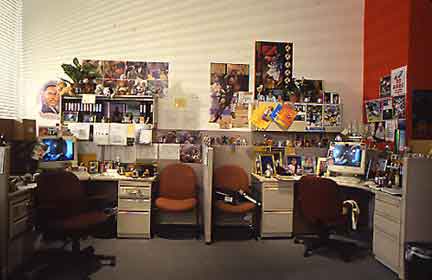
My Beating Heart
Courtesy Ronald Feldman Fine Arts, New York
Photo: Becket Logan
Pepon Osorioby Donald Goddard |
 My Beating Heart Courtesy Ronald Feldman Fine Arts, New York Photo: Becket Logan |
In the center of the main gallery is a large cage piled high with the possessions--bicycle, TV set, furniture, boxes and boxes--of a family that has been dispossessed and is being helped by the Philadelphia Department of Human Services, where Osorio was artist-in-residence for a year. Around the cage are endless files and more boxes for clients' papers, a small meeting room, and the desks of the director and four other social workers, all of which have personal photos on them and on the walls, posters and other pictures (the Philadelphia Eagles, the Philadelphia Seventy-Sixers, tourist sites in Puerto Rico), souvenirs, printed sheets of regulations and opportunities, etc. A TV monitor stashed in one side of the cage has a loop of home videos of the dispossessed family, and a continuously playing audiotape of an interview between mother and social worker, primarily about the difficulties of the teenage son. A despairing image of him holding his head appears on a screen in the little interview room. A like image of his younger sister appears on each of the computer monitors at the five desks and on a Venetian blind, as though they inhabited those places, like wood sprites. A TV monitor stashed in one side of the cage has a loop of home videos of the dispossessed family, and a continuously playing audiotape of an interview between mother and social worker, primarily about the difficulties of the teenage son. A despairing image of him holding his head appears on a screen in the little interview room. A like image of his younger sister appears on each of the computer monitors at the five desks and on a Venetian blind, as though they inhabited those places, like wood sprites. |
| The family and workers are real, the possessions are real, and so essentially are the desks and their accoutrements. It is impossible to escape the entanglements of all these images and objects. They form a pervasive consciousness, from which there is no escape, though much of this three-dimensional collage--the vacation and sports pictures, the ordering of everything toward solution, etc.--is about escape. But then even pictures of Allen Iverson playing basketball, or of hotels in Puerto Rico, double back on themselves. They are parts of the walls that surround everything, including the cubic cage at the center containing the objects that form a life, lives. It is like one of Dante's circles of hell, in which punishment, the wailing and gnashing of teeth, is played out by the children. |
 Face to Face Courtesy Ronald Feldman Fine Arts, New York Photo: Becket Logan |
| Osorio has added to this scene an army of ceramic figurines, surrounding and almost invading the desks, of plastic toy figures and snow domes (those transparent plastic-enclosed scenes upon which snow seems to fall when you turn them over and back), and, on one wall, cartoons from The New Yorker concerning the vagaries of middle-class "American" families. The effect is to further crowd out reality, that is, the reality of the individual lives being lived, particularly those of the brother and sister, which have already been crowded out by the "reality" of displaced objects and hope and fantasy and talk. There is literally no room left for the people involved except as it is materialized in the ambience, in the categorization of files and boxes, pictures and regulations. But then, it is also clear in this mélange that everyone has their own lives, which intertwine with each other in ultimately unpredictable ways. What is on the walls and desks, in the cage and computers, is separate but also bound together, however artificially. |
 Detail of Face to Face Courtesy Ronald Feldman Fine Arts, New York Photo: Becket Logan |
|
And the binding appears over and over again in doubling (as my wife Helen pointed out). The statuettes are often pairs. Double images appear on the wall: the two sides of a heart, a Rorschach drawing. Within the multitude is a powerful sense of binary structure: two people talking, brother and sister, male and female, brown skin and white skin, themes that have been present before in Las Twines (1999) and other works by Osorio. Conversely, coupling produces profusion, proliferation, but twos also contain ones. It represents procreation, creativity, but also the inevitable and singular despair of the individual. Donald Goddard © 2002 |
 Detail of Face to Face Courtesy Ronald Feldman Fine Arts, New York Photo: Becket Logan |
Art Reviews Listings - Previous Review - Next Review
Art Review - NYArtWorld.com - NYAW.com. All artwork is copyright of the respective owner or artist. All other material © Copyright 2015 New York Art World ®. All Rights Reserved.
New York Art World ® - Back to Top